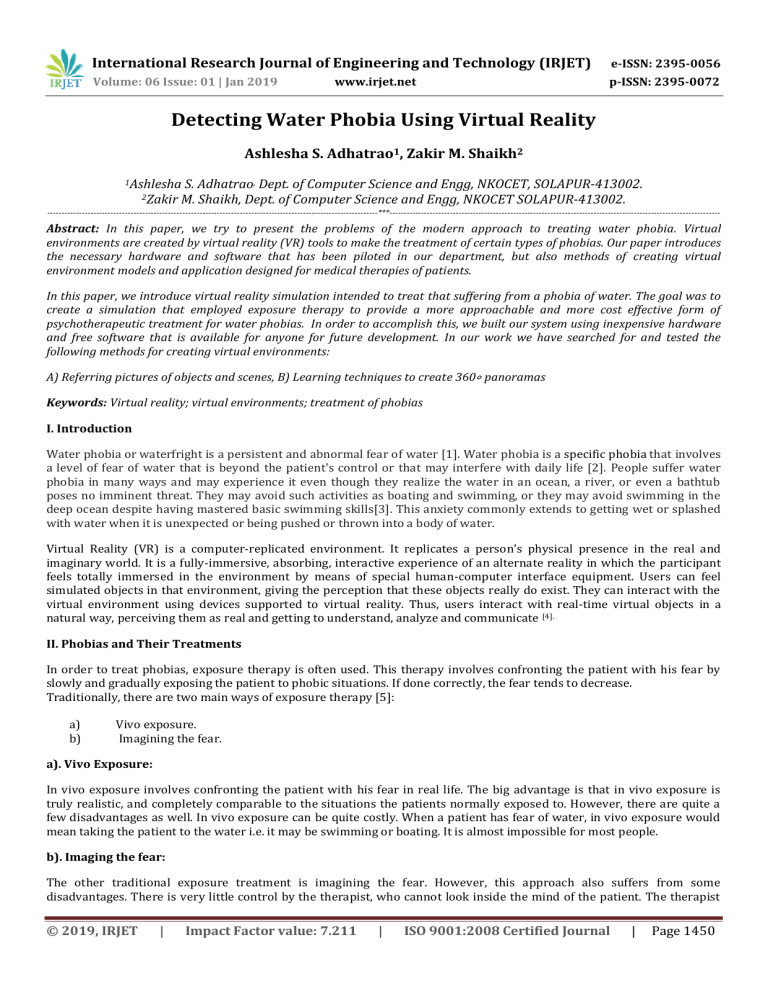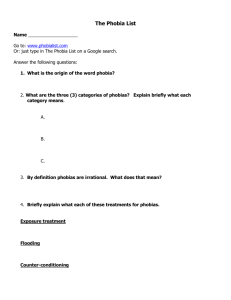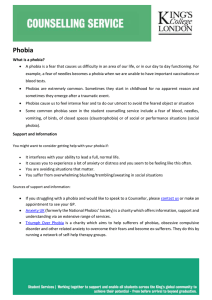IRJET-Detecting Water Phobia using Virtual Reality
advertisement

International Research Journal of Engineering and Technology (IRJET) e-ISSN: 2395-0056 Volume: 06 Issue: 01 | Jan 2019 p-ISSN: 2395-0072 www.irjet.net Detecting Water Phobia Using Virtual Reality Ashlesha S. Adhatrao1, Zakir M. Shaikh2 1Ashlesha 2Zakir S. Adhatrao, Dept. of Computer Science and Engg, NKOCET, SOLAPUR-413002. M. Shaikh, Dept. of Computer Science and Engg, NKOCET SOLAPUR-413002. -------------------------------------------------------------------------------------------------------------------***------------------------------------------------------------------------------------------------------------------- Abstract: In this paper, we try to present the problems of the modern approach to treating water phobia. Virtual environments are created by virtual reality (VR) tools to make the treatment of certain types of phobias. Our paper introduces the necessary hardware and software that has been piloted in our department, but also methods of creating virtual environment models and application designed for medical therapies of patients. In this paper, we introduce virtual reality simulation intended to treat that suffering from a phobia of water. The goal was to create a simulation that employed exposure therapy to provide a more approachable and more cost effective form of psychotherapeutic treatment for water phobias. In order to accomplish this, we built our system using inexpensive hardware and free software that is available for anyone for future development. In our work we have searched for and tested the following methods for creating virtual environments: A) Referring pictures of objects and scenes, B) Learning techniques to create 360∘ panoramas Keywords: Virtual reality; virtual environments; treatment of phobias I. Introduction Water phobia or waterfright is a persistent and abnormal fear of water [1]. Water phobia is a specific phobia that involves a level of fear of water that is beyond the patient's control or that may interfere with daily life [2]. People suffer water phobia in many ways and may experience it even though they realize the water in an ocean, a river, or even a bathtub poses no imminent threat. They may avoid such activities as boating and swimming, or they may avoid swimming in the deep ocean despite having mastered basic swimming skills[3]. This anxiety commonly extends to getting wet or splashed with water when it is unexpected or being pushed or thrown into a body of water. Virtual Reality (VR) is a computer-replicated environment. It replicates a person’s physical presence in the real and imaginary world. It is a fully-immersive, absorbing, interactive experience of an alternate reality in which the participant feels totally immersed in the environment by means of special human-computer interface equipment. Users can feel simulated objects in that environment, giving the perception that these objects really do exist. They can interact with the virtual environment using devices supported to virtual reality. Thus, users interact with real-time virtual objects in a natural way, perceiving them as real and getting to understand, analyze and communicate [4]. II. Phobias and Their Treatments In order to treat phobias, exposure therapy is often used. This therapy involves confronting the patient with his fear by slowly and gradually exposing the patient to phobic situations. If done correctly, the fear tends to decrease. Traditionally, there are two main ways of exposure therapy [5]: a) b) Vivo exposure. Imagining the fear. a). Vivo Exposure: In vivo exposure involves confronting the patient with his fear in real life. The big advantage is that in vivo exposure is truly realistic, and completely comparable to the situations the patients normally exposed to. However, there are quite a few disadvantages as well. In vivo exposure can be quite costly. When a patient has fear of water, in vivo exposure would mean taking the patient to the water i.e. it may be swimming or boating. It is almost impossible for most people. b). Imaging the fear: The other traditional exposure treatment is imagining the fear. However, this approach also suffers from some disadvantages. There is very little control by the therapist, who cannot look inside the mind of the patient. The therapist © 2019, IRJET | Impact Factor value: 7.211 | ISO 9001:2008 Certified Journal | Page 1450 International Research Journal of Engineering and Technology (IRJET) e-ISSN: 2395-0056 Volume: 06 Issue: 01 | Jan 2019 p-ISSN: 2395-0072 www.irjet.net cannot see what the patient is imagining, and therefore can only judge by the patients’ words if the correct degree of exposure is being used. Too little fear will not be effective, while too much fear can be harmful. Also, some patients have trouble imagining the fear at all, so this type of exposure treatment is out of the question. Most disadvantages of both in vivo exposure and imagining don’t apply, while most of the advantages remain. E.g., the therapist has more control over the experience and can stop the treatment right away. Also, treating fear of water is a lot less costly, and patient confidentiality will not be violated because the treatment takes place in the therapist’s practice. In order to immerse patients in a virtual environment, two main virtual reality setups are used: Head Mounted Display (HMD) and Computer Automatic Virtual Environment (CAVE) [4]. HMD uses a headset, which totally shuts the patient off from the real world. III. Use of Cognitive and Behavioural Therapies: The water phobia, as every phobia which is a nuisance for daily life, needs a treatment [9]. For this, the French National Authority for Health [11] advises using the Cognitive and Behavioural Therapies (CBT). This kind of psychotherapies is based on the principles of the classical conditioning and operant conditioning for the behaviors while considering cognitions and emotions [10]. Nowadays, the use of CBT for phobias is widespread. For all that, CBT is still an object of researches especially within the framework of new technologies [12]. That is how the use of virtual reality has emerged with the same based principles as the CBT: the exposition to the problematic stimulus to result in a deconditioning of the anxious response [13]. IV. Efficacy of Virtual Reality Exposure: Numerous virtual reality exposure protocols have been tested. Their effectiveness has been proven, and it has even been estimated that such effectiveness was equal or superior to those of the in vivo exposure. Most of the studies were about treating phobias through virtual reality without expending their research to water phobia. A virtual reality therapy, the measurements concerned the heart rate and the response time during a computer-based test carried out in attendance of a phobic object. After the virtual reality intervention, the authors observed a decrease in the heart rate during the presence of the phobic object. A reduction of response time to the computer-based test was also triggered. In 2002, Emmelkamp et al. [14][15] worked on the efficacy of the in virtual exposure at low cost in comparison to the classical in vivo exposure. Their results allowed them to conclude that the virtual reality exposure, even at low cost, is as efficient as the real exposure. V. Virtual Setup: The equipment consists of two different parts. The first part is VR, the second part is pulse rate, monitor. VR contain VR lens and smartphone. VR lens is come from google cardboard. And smart phones with supported VR applications are used as a screen to show the VR video. In this, pulse rate was used as a parameter to show the result of this water phobia VR. At first, when a water-discomfort user gets into the water, he or she will become very anxious and the corresponding physiological response is that the heart rate increase quickly. Pulse rate monitor produced by Arduino was used in this project. This monitor has two parts, one Monitor display, and one heart rate sensor. The sensor should be clipped around the chest and adjust the strap to fit snugly. After about 20 seconds, the heart rate will show on the watch. We can record all of the rate data and then compare the data in a different situation. In our system, the patient (water phobic) has given a Head Mounted Display (HMD). The HMD is just what it sounds like - a computer display you wear on your head. Most HMDs are mounted in a helmet or a set of goggles. The Virtual environment is a computer simulation that uses 3D graphics and devices such as the Data Glove to allow the user to interact with the simulation. Virtual Reality platform refers to a high-end user interface that involves real-time simulation and interactions through multiple sensorial channels. The real-time monitoring system is used for measuring the: Heart rate Respiration rate Skin conductance © 2019, IRJET | Impact Factor value: 7.211 | ISO 9001:2008 Certified Journal | Page 1451 International Research Journal of Engineering and Technology (IRJET) e-ISSN: 2395-0056 Volume: 06 Issue: 01 | Jan 2019 p-ISSN: 2395-0072 www.irjet.net Fig 1. System Architecture VI. Conclusions: Virtual reality has thus finally begun to shift away from the purely theoretical (virtual dream) and towards the practical (a close reality).Virtual reality with respect to the treatment of phobias is a good alternative for established methods of treatment, and offers a lot of advantages over these established methods, e.g. it offers more control for the therapist, is safer, less costly and less embarrassing. Also, there might be some lower bound on the virtual environment in order for patients to feel present. More advanced virtual environments don’t (or to a much lesser extent) influence effectivity anymore. In this paper, we explored the probability of using the self-designed water virtual reality headset to help patients who has mild Aqua phobia which makes them discomfort in the water to overcome the fear of drowning in the water. Based on the past successful experiments of the VR therapies, we assessed our hypothesis by designing a VR headset which combines with the stereoscope lens and the smartphone which lets us to detect and compare users’ heart rate with and without wearing VR headset. VII. References: [1] Tomasz Mazuryk and Michael Gervautz, Virtual Reality History, Applications, Technology and FutureInstitute of Computer Graphics Vienna University of Technology, Austria [mazuryk|gervautz]@cg.tuwien.ac. [2] Strickland, D., Hodges, L., North, M., Weghorst, S. Overcoming phobias by virtual exposure. In: Communications of the ACM, 40, 8 (August 1997), p.34-39. [3] Segal R, Bhatia M, Drapeau M (2011) Therapists' Perception of Benefits and Costs of Using Virtual Reality Treatments. Cyberpsychology, Behavior, and Social Networking 14(1- 2): 29–34. [4] North, M.M., and North, S.M. (1994). Virtual environments and psychological disorders. Electronic Journal of Virtual Culture, 2(4), 37-42(ep.). © 2019, IRJET | Impact Factor value: 7.211 | ISO 9001:2008 Certified Journal | Page 1452 International Research Journal of Engineering and Technology (IRJET) e-ISSN: 2395-0056 Volume: 06 Issue: 01 | Jan 2019 p-ISSN: 2395-0072 www.irjet.net [5] Banos, R. M., Botella, C., Alcaniz, M., Liano, V., Guerrero, B., & Rey, B. (2004). Immersion and emotion: their impact on the sense of presence. Cyberpsychology&Behavior, 7, 734–741. doi:10.1089/cpb.2004.7.734 PMID: 15687809 [6] Alex Senson Virtual Reality Therapy: Treating The Global Mental Health Crisis CRUNCH NETWORK Posted Jan 6, 2016 [7] Wiederhold, B.K., Wiederhold, M.D., Fraser, G.,Fisher, S.S., Oyama, H., Katsumata, N., Ohsuga,M., Tatsuno, Y. How real-time technology can improve the quality of life. In: ACM SIGGRAPH Computer Graphics, 33, 2 (May 1999), p.25-29 [8] Albert Rizzo, JoAnn Difede, Barbara O. Rothbaum, J. Martin Daughtry, Greg Reger. ”Virtual Reality as a Tool for Delivering PTSD Exposure Therapy” Post-Traumatic Stress Disorder: Future Directions in Prevention, Diagnosis, and Treatment. Springer, 2013 [9] Bryson, S., Zeltzer, D., Bolas, M.T., Chapelle, B.D., Bennett, D., and Spitz, E.L., “The Future of Virtual Reality: Head Mounted Displays versus Spatially Immersive Displays,” SIGGRPAH’96 Panel Session, 1996. [10] Palazzolo, J. (2010). La gestion du stress et de l’aquaphobie par les TCC - L’apport de la plongée sous-marine. Mon Petit Éditeur. [11] Cottraux, J. (2014). Thérapie cognitive et émotions: la troisième vague (2ème édition), p 1-27 Issy-les-Moulineaux (Hauts-de-Seine): Elsevier Masson. [12] Haute Autorité de la Santé, Affections psychiatriques de longue durée: Troubles anxieux graves, guide de juin 2007. [13] Berry, R. R. and Lai, B. (2014). The emerging role of technology in Cognitive-Behavioral therapy for anxious youth: a review. Journal of rational-emotive & cognitive-behavior therapy 32 (1), 57-66. [14] Raghav, K., Van Wijk, A., Abdullah, F., Islam, M. N., Bernatchez, M. and De Jongh, A. (2016). Efficacy of virtual reality exposure therapy for treatment of dental phobia: a randomized control trial. BMC oral health 16 (25). [15] Emmelkamp, P. M. G., Krijn, M., Hulsbosch, A. M., de Vries, S., Schuemie, M. J. and van der Mast. (2002). Virtual reality treatment versus exposure in vivo: a comparative evaluation in acrophobia. Behaviour research and therapy 40, 509-516. © 2019, IRJET | Impact Factor value: 7.211 | ISO 9001:2008 Certified Journal | Page 1453



